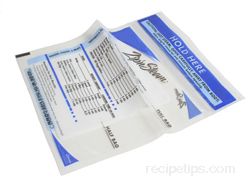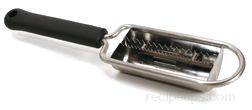|
Cooking Times | Baking Fish | Pan-frying Fish | Deep-Frying Fish
Grilling & Broiling Fish | Doneness | Cooking Tips
Fish can be prepared using almost any type of cooking method including baking, steaming, frying, grilling, broiling, or slow cooking. When cooking fish, care must be taken not to overcook the fillet, steak, or whole fish, which results in dry and somewhat tasteless meat. A general rule is to cook a fish 10 minutes for each inch of thickness. The 10 minute rule should not be used for deep-frying or microwaving fish. The fish should be cooked until it has reached an internal temperature of at least 145ºF.
Fish Cooking Times
Fish cooking temperatures are important to monitor in order to insure meat is safely cooked to the proper temperature. When preparing fish, use the chart below as a guide to check doneness when the fish is oven baked, pan-fried, deep-fried, grilled, and steamed.
Baking Fish
Baking is a good method to use for cooking whole fish, stuffed or unstuffed, and large, thicker cuts. Baking can also be used for steaks and fillets. While baking, the fish should be basted to keep the meat moist.
|
Preparation
- Keep the fish refrigerated until ready to cook.
- Rinse the fish thoroughly inside and out. Pat it dry with paper towels. When baking whole fish, the head can be left on if there is room in the baking pan.
- If stuffing a whole fish, add it to the cavity of the fish.
- Place the whole fish or pieces in an oiled baking pan. If baking oily fish, it should be placed on an oiled rack so it is not setting in the juices as it bakes.
- Baste the fish with a mixture of 1/2 cup of melted butter and 1 tablespoon of lemon juice.
- Cover the pan with aluminum foil.
| Note: Whole large fish can be hard to place in and remove from the baking pan. To make this process easier, make a bed of aluminum foils to place the fish on before placing in the baking dish. Grease the foil and make it wide enough so that there is enough foil to grab when placing it in and removing it from the pan. | |
|
Baking
- Place the covered baking pan in an oven preheated to 350°F.
- Bake for 25 to 45 minutes, depending on the quantity being cooked. See the chart above.
- Baste the fish with the butter/lemon mixture 2 or 3 times during the cooking time.
- Test the fish for doneness by inserting a fork into the thickest area for the fillets or steaks and in the backbone above the dorsal fin of whole fish. Twist the fork and the meat should flake easily and be opaque in appearance.
- To brown steaks and fillets, baste them with the pan juices and then place under the broiler for approximately a minute.
- Carefully remove the fish from the pan by using a spatula to lift the fish out. Place on a platter or plate for serving.
- Whole fish should have the skin and bones removed.
|
Pan-frying Fish
Pan-frying fish is a popular method of cooking fish. It works well with small whole fish, steaks and fillets. Lean fish are better pan-fried than oily fish because the oil helps keep them too moist. Oily fish are better cooked using a method that allows their natural fat to drain while cooking, such as broiling, grilling or steaming. Instructions for pan-frying whole and pieces of fish are shown below.
Pan-frying Whole Fish
Small fish that are less than 1 1/2 inches thick work well to panfry. If thicker than 1 1/2 inches they should be filleted before frying. Frying the fish in butter would give it the best flavor but butter burns too easily. To get the benefit of the butter flavor use half butter and half vegetable oil. Vegetable oil can also be used on its own if desired.
|
Preparation
- Keep the fish refrigerated until ready to cook.
- When frying whole fish, the head is generally removed before cooking.
- Rinse the fish thoroughly inside and out. Pat it dry with paper towels.
- Heat oil in a heavy skillet over medium heat. Be sure oil is hot enough before beginning to fry the fish. A drop of water added to the oil should sizzle when the oil is heated properly.
- Dredge the fish in flour seasoned with salt and pepper to assist the browning process.
|
|
Pan-frying
- Place the floured fish in the hot oil. Place only 2 or 3 fish in the pan at one time so that they are not crowded. Frying too many at one time cools the oil down too much, causing the fish to absorb more oil.
- Fry the fish for 5 to 8 minutes on the first side. Turn over and cook another 4 to 7 minutes. Cooking time will depend on the thickness of the fish.
- When the fish is done its skin should be browned and crisp. When inserting a fork in the backbone, the meat should flake and separate from the bone easily. The internal temperature of the fish should be 145°F.
- Remove from the pan and place on a paper towel lined platter so the grease can drain. If frying more fish, place the cooked fish in an oven preheated to 175°F to 200°F to keep them warm while more are cooking.
- Add more oil if cooking additional fish. Allow the oil to heat up properly before frying more fish.
|
Pan-frying Steaks and Fillets
Fish steaks or fillets should not be thicker than 1 1/2 inches. Slice any pieces over 1 1/2 inches thick into thinner fillets. When frying, cook pieces with similar thickness together so that they cook evenly.
|
Preparation
- Keep the fish refrigerated until ready to cook.
- If necessary, slice thick cuts into thinner pieces. Cut fillets into even serving size pieces.
- Rinse the fish thoroughly and pat dry with paper towels.
- Heat oil in a heavy skillet over medium heat. Be sure oil is hot enough before beginning to fry the fish. A drop of water added to the oil should sizzle when the oil is heated properly.
- Dredge the fish in seasoned flour or a crumb coating to assist the browning process. See crumb coating below.
Crumb Coating:
- Moisten pieces in a mixture of one beaten egg and one tablespoon of water. Double these ingredients if frying a larger quantity of fish.
- Dip egg coated pieces in seasoned crumb mixture. Use flour, bread crumbs, cracker crumbs, or crushed cornflakes for the crumbs and season with salt and pepper.
|
|
Pan-frying
- Place the coated fish in the hot oil. Place only a few pieces of fish in the pan at one time so that they are not crowded. Frying too many at one time cools the oil down too much, causing the fish to absorb more oil. Fry consistent size pieces together so they cook evenly.
- Fry the fish for 3 to 5 minutes on the first side. Turn over and cook another 2 to 5 minutes. Cooking time will depend on the thickness of the fish.
- When the fish is done its crumb coating should be browned and crisp. When inserting a fork in the fish, the meat should be flakey and opaque in appearance. The meat should be moist but not watery. The internal temperature of the fish should be 145°F.
- Remove from the pan and place on a paper towel lined platter so the grease can drain. If frying more fish, place the cooked fish in an oven preheated to 175°F to 200°F to keep them warm while more are cooking.
- Add more oil and allow the oil to heat up properly before frying more fish.
|
Deep-Frying Fish
Deep-frying, also known as deep-fat frying, is a process of immersing food in a pan containing hot oil, which cooks the food quickly, producing a crispy surface covering a tender and moist interior. For the best results as well as for ease in handling, it is best to use small pieces of fish when deep-frying. Fish is often covered with flour and seasonings or some type of batter before deep-frying, which provides a crispy, brown crust on the food.
Any cooking oil can be used for deep-frying provided it does not smoke or burn at temperatures that may reach as high as 375°F. See Oil Smoke Points to assist in selecting oil for deep-frying. Oil low in saturated fat is best to use because the fish will absorb a small quantity of oil during the cooking process. See Fat Composition of Various Oils to assist in selecting oil low in saturated fat.
| Checking the Temperature of the Oil |
- A temperature between 350°F and 375°F is an ideal range for deep-frying. The correct temperature can be determined with the use of a candy thermometer.
|
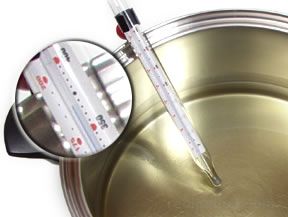 |
- Another method that can be used is to place a cube of bread into the oil and if it browns in 45 to 50 seconds, the oil is at the correct temperature.
|
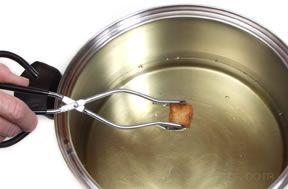 |
|
Deep-frying
- Carefully place the pieces of fish into the hot oil using tongs to handle the fish. Add three to four pieces to the oil, making sure not to overcrowd then in the pan. The number of pieces cooked at a time will depend on their size.
- Cook the fish according to the cooking times shown above for deep-frying fish. The fish should be golden brown when down.
- Remove from the oil and place on a platter lined with paper towels to allow excess grease to drain from the fish. Serve while hot.
If cooking a large amount, the fish can be placed on a baking sheet and placed in an oven preheated to 175°F to 200°F to keep them warm while more are cooking. |
Grilling and Broiling Fish
Grilling | Broiling
Grilling and broiling are very similar methods of cooking fish. They both use a dry heat that quickly cooks the surface and then slowly moves to the middle of the meat. The main difference between the two methods is that grilling applies the heat to the bottom surface of the fish, and broiling applies the heat to the top surface. Also, grilling infuses the fish with a smoky flavor from the meat juices that drip during the grilling process. When broiling, this infusion of flavor does not occur.
Grilling
Indirect Heat | Direct Heat
The grilling process cooks foods over a heat source, either directly, indirectly, or a combination of both. Grilling temperatures typically reach as high as 650ºF, but any temperature above 300°F is suitable as a grilling temperature. The high heat of grilling sears the surface of fish, creating meat with a flavorful crust. The required cooking temperature and the method of grilling (direct, indirect, or a combination) depends on the size of the fish or the pieces. It is important to cook the fish to its proper doneness but not to overcook.
There are many different types of grills available today that can be used when grilling fish. For information on the different types of grills, see Grilling Beef - Types of Grills. It is important that the grill is set up properly and reaches the appropriate temperature for the type of fish that is being grilled to ensure that it produces a moist and flaky finished product that is cooked to the proper doneness. For information on setting up a charcoal or gas grill, see Grilling Beef - Outdoor Grill Setup.
A medium heat should be used when grilling fish, whole or pieces. Using too high of a heat will cause some parts to cook too quickly and dry out while other parts will not be done all the way through. To check the temperature of the grill, use the palm of your hand for testing, see Charcoal Grill Setup - Estimating Temperature for testing method. The thicker the piece of fish the farther away from the heat source it should be or the heat source should be at a lower temperature to prevent the outside of the cut from burning before the inside is properly cooked. You will also have to decide whether you will use direct or indirect heat during the grilling time. Depending on the type of fish and size, you may use both. A whole fish or a thick piece may require direct heat to seal the outside and indirect to allow the cut to cook thoroughly to the center.
Indirect Heat
Cooking with indirect heat occurs when you use an area of the grill that is not directly over the heat source. Using indirect heat slows the cooking process down, which allows the center of the fish to cook thoroughly without burning the outside. On charcoal grills, coals are pushed to one side of the grill or banked into a ring around the outer edges. On gas grills, the side of the burner, which is below the area where the food will be placed, is turned off after the grill is preheated. Using one of the indirect setups will provide an area on the grill that is a low heat source. The fish is placed over the area in which there are no coals or over the burner that is turned off on a gas grill. Indirect heat is good for cooking whole fish or larger pieces.
To prepare the grill for indirect heat, see Beef Grilling - Indirect Heat for grill setup.
See general instructions below for cooking fish using indirect heat.
|
Preparation
- Keep the fish refrigerated until ready to grill.
- If skin has not been removed, keep it intact while grilling. The skin will prevent the fish from curling up and flaking apart. The skin is easily removed after grilling.
- Rinse the fish thoroughly and pat dry with paper towels.
- If preparing a whole fish, rinse the fish inside and out. Pat dry with paper towels and stitch cavity shut with butcher's twine. Cut 3 diagonal slits on each side of the fish.
- Brush the fish and grill grate with a thin coat of cooking oil to prevent sticking on the grill. Oil the grill grate before starting the grill.
- If a grill basket is used to hold the fish, be sure to oil that also.
|
|
Cooking
Use the indirect grilling method with a medium hot grill when cooking whole fish and thick fillets or steaks. |
- Place the fish skin side up on the grill grate over indirect heat area. Do not place directly over the heat source.
- Cook the fish for 10 minutes per inch of thickness. Turn to grill on the other side for approximately half way through time.
- Insert the tip of a knife in thickest area of the fish to check for doneness. The meat should be flakey and opaque in appearance. The internal temperature of the fish should be at least 145°F.
|
|
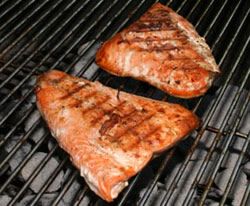 |
Direct Heat:
Cooking with direct heat occurs when you cook the meat directly over the heat source. The fish is cooked quickly over medium or high heat coals or over burners set to medium or high heat on a gas grill. Direct heat is used when grilling thinner fillets and steaks. Thin fish will cook quickly when grilled using direct heat. Because they are thin, the direct heat will cook them thoroughly through to the middle.
For more detailed setup information on grilling, using direct heat, see Beef Grilling.
|
Preparation
- Keep the fish refrigerated until ready to grill.
- If skin has not been removed, keep it intact while grilling. The skin will prevent the fish from curling up and flaking apart. The skin is easily removed after grilling.
- Rinse the fish thoroughly and pat dry with paper towels.
- Brush the fish and grill grate with a thin coat of cooking oil to prevent sticking on the grill. Oil the grill grate before starting the grill.
- If a grill basket is used to hold the fish, be sure to oil that also.
|
|
Cooking
Use the direct grilling method with a medium hot grill when cooking thinner fillets and pieces of fish.
- Place the fish skin side up on the grill grate over the direct heat source.
- Cook the fish for 4 to 6 minutes and then turn to grill on the other side for approximately same amount of time.
- Insert the tip of a knife in thickest area of the fish to check for doneness. The meat should be flakey and opaque in appearance. The internal temperature of the fish should be at least 145°F.
|
Broiling
When broiling fish, there is no benefit from the infusion of smoked flavoring that occurs when grilling, causing the fish to be fairly bland in taste. This can be remedied by the use of seasoning, such as a mixture of herbs, marinades or basting sauces.
|
Preparation
- Wash whole fish thoroughly and pat dry. Whole fish should be no more than 2 inches thick. If cooking fillets or steaks, rinse thoroughly, pat dry with paper towels and cut into serving size pieces.
- Brush the fish and the broiling pan with oil to prevent sticking.
- Place fish on broiler rack skin side down. Do not line the broiler rack with aluminum foil because it will prevent the drippings from falling into the pan below and the drippings that remain on the foil may cause flare-ups to occur.
- As with grilling, the distance from the heat source is important for producing fish that is golden brown, moist, flakey, and thoroughly cooked but not overcooked. To check for proper cooking distance for broiling, place the fish on the broiler rack and place the rack on the broiler pan. Set the broiler pan in the oven and measure the distance from the heat source in the oven to the top of the fish. It should be about 4 inches away for most fish and about 5 inches away for thin fillets and whole fish, adjust oven racks accordingly.
|
|
Cooking
- Preheat the broiler for 9 or 10 minutes.
- Place the broiler rack in the oven to begin broiling. As with grilling, it is necessary to watch the fish carefully as it cooks, making sure the edges are not cooking too fast and if they are, rearrange the pieces or adjust the heat accordingly.
- Cook whole fish and 1" thick steaks for approximately 5 minutes per side and fillets for approximately 3 minutes per side. Cooking time will vary with the thickness of the fish. Watch fish closely as it is cooking, especially very thin fillets so that it does not overcook.
- Baste at least one time while cooking on the first side. Oil or melted butter (or margarine) can be used for basting or a little lemon can be added to the butter for extra flavor.
- Carefully turn the fish to finish cooking. Baste at least once while cooking on second side.
- When grilling or broiling, all the pieces will not cook at the same rate so it is necessary to remove them as they finish cooking to avoid overcooking.
- Insert the tip of a knife in thickest area of the fish to check for doneness. The meat should be flakey and opaque in appearance. The internal temperature of the fish should be at least 145°F.
|
Checking Doneness
There are several methods that can be used to check for the doneness of fish. Some methods work better on some types of fish than others. Similar to meat, fish continues to cook after removing it from the heat. So for a more flavorful result, begin checking for doneness a few minutes before the end of the estimated cooking time. Since the meat of the fish is somewhat translucent, it begins to become opaque as it cooks, which is one method of visually checking for doneness, especially for fillets that are most often not as thick as fish steaks.
The best procedure for checking doneness is to use a cooking thermometer, checking to make sure the fish has reached an internal temperature of 145ºF. To cook fish steaks that are slightly translucent in the center, remove the steaks from the heat when they reach an internal temperature of 135ºF to 140ºF. The fish steaks will continue cooking with the retained heat if they are covered and left to stand a few minutes prior to serving.
Listed below are other methods that can be used to check for doneness.
- To check the fish for doneness, use the tip of a sharp knife and cut through the thickest part of the fillet. If the fish has been properly cooked, the meat will appear opaque but will still be moist. Some varieties of fish contain more fat, such as salmon or tuna, which can be cooked until opaque on the outside while remaining somewhat translucent on the inside.
- Another test to use for doneness is to check the meat with a knife to see if it is firm and beginning to separate or "flake". If the fish flakes too easily, it may be overcooked. The meat should slightly resist separating, but still be able to be separated, thus indicating it is moist and not too dry.
- When cooking fish that has not been boned, such as trout or pan fish, the meat should not drop off the bones, but instead should slightly resist removal.
Cooking Tips:
- Rub lemon juice on fish before cooking. This will help the fish maintain its color and add to its flavor.
- Flour is often used as a coating for foods that are fried. Pieces of fish are often pan-fried with a flour coating, which develops a crisp, flavorful crust, and an interior that is tender flaky.
- Fish that is less than 1/2 inch thick do not require turning when cooking.
- Increase cooking time when cooking fish that is frozen.
- For moister broiled fish, first steam or poach the fish until close to being done and then brown it under the broiler.
- It is best to grill, broil, steam or poach oily fish so that their natural fats can drain while they are cooked.
|















